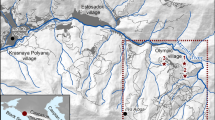Abstract
The evolution of large-scale landslides should be studied because, over long periods of time, primary remediation measures may suffer reduced efficiency or have to be adjusted many times. The 102 Landslide in southeast Tibet, which originally formed in 1991 with a volume of 5.1 million m3 and still exhibits post-failure activity, provides a distinctive case study. The landslide evolved from earthquake destruction and unloading, rainfall-triggered sliding, and debris flow to sands sliding slopes. The NE ringed scarp receded by 38.96 m during a five-year period (2003–2008). The total recession was 160 m with a total area of 2500 m2 during a 17-year period (1991–2008). Although several types of remediation measures were applied and were temporarily effective, the normal function of the Sichuan–Tibet Highway was affected by landslide reactivation from time to time. Actual effects of the engineering measures such as retaining walls, prestressed anchor cables, and drainage ditches confirm that hasty governance of this type of large-scale landslide is generally unfeasible over long time periods. Finally, an approach involving a tunnel running backward from the front face has been adopted as a permanent solution to large-scale moraine slope failures: This engineering practice has been in progress since April 2012. This paper describes the evolution of the 102 Landslide, the engineering interventions to mitigate the effects of the landslide on the Sichuan–Tibet Highway, and the choice of tunneling as a final mitigation measure. The present study concludes that approaches that allow escape from developing geo-hazards should always be the initial choice.
















Similar content being viewed by others
References
Djokic D, Ye Z, Dartiguenave C (2011) Arc hydro tools overview. http://downloads.esri.com/blogs/hydro/ah2/arc_hydro_tools_2_0_overview.pdf. Accessed 17 Jan 2016
Evans SG, Mugnozza GS, Strom AL, Hermanns RL, Ischuk A, Vinnichenko S (2006) Landslides from massive rock slope failure and associated phenomena. In: Landslides from massive rock slope failure, part 1, vol 49. NATO science series: IV—earth and environmental sciences, pp 3–52
IMHE and ITS (1999) A study of typical mountain hazards along Sichuan-Tibet Highway. IMHE (Institute of Mountain Hazards and Environment, the Chinese Academy of Sciences and Water Conservancy Ministry of China) and ITS (Institute of the Traffic Science, the Traffic Department of the Tibet Autonomous Region). Chengdu Science and Technology University Publishing House, Chengdu, pp 158–184 (in Chinese with English preface)
Iturrizaga L (1999) Typical debris accumulation forms and formations in High Asia—a glacial-history-based concept of the origin of Postglacial debris accumulation landscapes in subtropical high mountains with selected examples from the Hindu Kush, the Karakoram and the Himalayas. GeoJournal 47(1–2):277–339
Iturrizaga L (2001) Lateroglacial valleys and landforms in the Karakoram Mountains (Pakistan). GeoJournal 54(2–4):397–428
Liao QL, Yang ZF, Shang YJ, Zhang LQ (2004) Back analysis of slip surface of the 102 landslide on Sichuan-Tibet Highway. Chin J Rock Mech Eng 24:4119–4123 (in Chinese with English abstract)
Parise M, Sorriso-Valvo M, Tansi C (1997) Mass movement related to tectonics in the Aspromonte massif (Southern Italy). Eng Geol 47(1):89–106
Philip H, Ritz JF (1999) Gigantic paleolandslide associated with active faulting along the Bogd Fault (Gobi-Altay, Mongolia). Geology 27(3):211–214
Schenk PM, Bulmer MH (1998) Origin of mountains on Io by thrust faulting and large-scale mass movement. Science 279(5356):1514–1517
Shang Y, Yue Z, Yang Z, Wang Y, Liu D (2003) Addressing severe slope failure hazards along Sichuan-Tibet Highway in Southwestern China. Episodes 26(2):94–104
Shang YJ, Park HD, Yang Z, Yang J (2005a) Distribution of landslides adjacent to the northern side of the Yarlu Tsangpo Grand Canyon in Tibet. China Environ Geol 48(6):721–741
Shang YJ, Park HD, Yang Z (2005b) Engineering geological zonation using interaction matrix of geological factors: an example from one section of Sichuan-Tibet Highway. Geosci J 9(4):375–387
Strecker MR, Marrett R (1999) Kinematic evolution of fault ramps and its role in development of landslides and lakes in the northwestern Argentine Andes. Geology 27(4):307–310
Sun HL (1996) Formation and evolution of Tibetan Plateau. Shanghai Science and Technology Press, Shanghai, pp 180–181
Tachikawa T, Hato M, Kaku M, Iwasaki A (2011) Characteristics of ASTER GDEM version 2. In: 2011 IEEE international, geoscience and remote sensing symposium (IGARSS), pp 3657–3660
TPSRT (The Tibet Plateau Synthesis Scientific Research Team of Chinese Academy of Sciences) (1982) Natural geography of Tibet. Science Press, Beijing, pp 14–118 (in Chinese)
TPSRT (The Tibet Plateau Synthesis Scientific Research Team of Chinese Academy of Sciences) (1986) Glaciers of Tibet. Science Press, Beijing, pp 14–118 (in Chinese)
Wang CH, Zhang XG (1998) Analysis on formation and developing process of the 102 Landslide group on Sichuan-Tibet Highway. In: Research on mountain disasters and environmental protection across Taiwan Strait, vol 1, pp 251–255 (in Chinese)
Zeng QL (2006) Formation of huge-thick loose accumulation with associated hazards occurrence modes and mitigations: a case study in Ranwu to Lulang section of Sichuan-Tibet Highway. Dissertation, Institute of Geology and Geophysics, Chinese Academy of Sciences
Zhang X, Wang C, Kong J, Zhu P (1998) Analysis on characteristics of 102 Landslide group in Sichuan-Tibet road. Mt Res 16(2):151–155 (in Chinese with English abstract)
Zhang P, Shen Z, Wang M, Gan W, Bürgmann R, Molnar P, Wang Q, Niu Z, Sun J, Wu J, Hanrong S, Xinzhao Y (2004) Continuous deformation of the Tibetan Plateau from global positioning system data. Geology 32(9):809–812
Zhu PY, Wang YC, Zhang XG (1998) Engineering geological characteristics of the 102 Landslide group in the Sichuan-Tibet Highway. In: Researches on mountain disasters and environmental protection across Taiwan Strait, vol 1, pp 246–250 (in Chinese)
Zhu PY, Wang CH, Tang BX (2000) The deposit characteristic of supper debris flow in Tibet. J Mt Sci 18(5):453–456 (in Chinese with English abstract)
Acknowledgements
The authors appreciate supports from the Chinese Natural Science Foundation Committee (No. 41372324), the Brain Korea 21 Plus Project, and the Research Institute of Energy and Resources, Seoul National University.
Author information
Authors and Affiliations
Corresponding author
Rights and permissions
About this article
Cite this article
Shang, Y., Hyun, CU., Park, HD. et al. The 102 Landslide: human–slope interaction in SE Tibet over a 20-year period. Environ Earth Sci 76, 47 (2017). https://doi.org/10.1007/s12665-016-6365-z
Received:
Accepted:
Published:
DOI: https://doi.org/10.1007/s12665-016-6365-z




